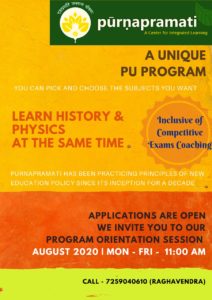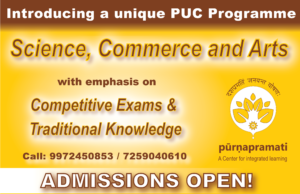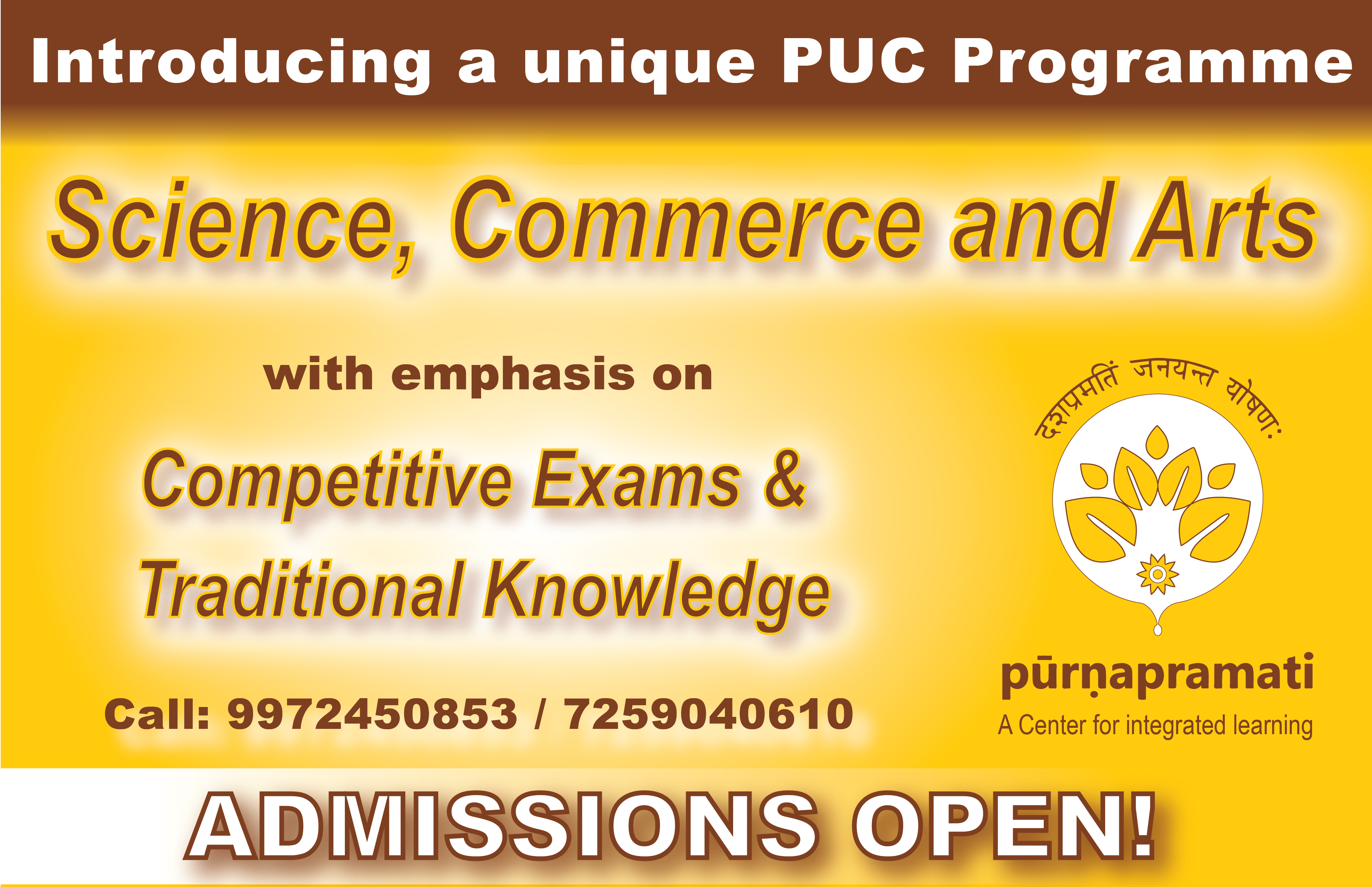
Recent Updates
Subscribe


Dhanvatari Jayanti : Educating about various medicinal plants
Wednesday, December 12th, 2012Dhanvanthri Jayanthi celebration at Purnapramati Pre-primary on 12-12-2012 The event started by 9:30 am, with a welcome speech by Uma, the guests were Sri Jayanna, an Ayurvedic doctor from Sawana Durga and parents of an M2 child Aadith L. As a part of the theme of the year-WATER, the theme for this event was ‘Samudra’ the Ocean. The program was started by lighting the lamp by guest, principal and children. Children sung an invocation ‘Shakthi Sahitha Ganapatim’. Our Sanskrit teacher Muralidhar spoke about the significance of the day and narrated the story Samudhra Manthana and Dhanvanthri’s birth. Children recited a shloka on Dhanvanthri. Children enacted the skit of “Sagarollanghana” and “Sanjeevini Parvatha”. There was a dance representing the ocean ‘Bangara Neera Kadalachegeec Hegide’ a poem by Da Ra Bendre. Then the guest addressed the children, showed them different plants and explained the medicinal uses of these plants. An informal vote of thanks was given by Uma. Dhanvanthri Jayanthi celebration at Purnapramati Primary on 12-12-2012 Dhanvantari jayanthi of this year celebrated on 12th Dec excellently exemplified the integration of Indian traditional, indigenous and the modern knowledge systems that has been the sole focus of Purnapramati. It was a one and a half hour program with a very versatile guest Sri Jayanna, a dweller of Savanadurga forests. The program began with the lighting of lamp by the guest. Anantanna then guided the children chant a shloka on Lord Dhanvantari. Our principal introduced the guest to the children. Sri Jayanna then addressed the children and the teachers educating about numerous medicinal plants, their appliances and their botanical and ethnic kannada names. Some of them are listed here: Tulasi – A medicine for cold, caugh and fever, Ondelaga – A medicine for Jaundice, Amrutaballi(Tinospora Cordifolia) – A medicine for Jaundice and Diabetes, Tincher – An applicant for wounds, Dodda patre(coleus amboinicus) – A medicine to improve digestion, loLe sara(Alovera , Kumari) – A skin smoothner, Madhunashini(Gymnema Sylvestre) – A popular medicine for diabetes, Nelabevu(Andrographis panikulata) – A drug for snake bites, Kakke kayi – A medicine for jaundice, Majjige beru or ashadi beru or halavu makkala tayi – A medicine to improve mother’s milk, Bevina chekke(Neem tree’s peel ) – A medicine for joint pain, Belada hannu(wood apple) – A popularly used fruit to make juice which is also an excellent medicine for heart problems. Sri Jayanna also quoted a few methods of making medicines at home using the parts of popular plants like mango, bilva, etc. He also warned the gathering of the fake enterprise of medicine in the present day and insisted upon self cultivation. He also shared the experience of saving himself from fatal condition of severe appendicitis through self medication using bilva patre and dieting. Concluding his talk, Sri Jayanna gave a call to the children and the teachers to conserve the neglected herbal families like the very sparsely found(only in 8 districts in Karnataka) Makliberu . His gave the slogan ULISI BELESI BALASI. Very much inspired by the guest the children and the team members of Purnapramati together swore to foster at least two of the introduced plants from the very day. Accordingly all the children were given with two plants to take home and the teachers with five each. For more photos click here

Rock Climbing & Rappling
Monday, December 10th, 2012ಪರಿಪೂರà³à²£ ಕಲಿಕೆಯ ತಾಣವಾದ ನಮà³à²® ಪೂರà³à²£à²ªà³à²°à²®à²¤à²¿ ಶಾಲೆಯಲà³à²²à²¿ ಈ ಬಾರಿ ಮಕà³à²•à²³à²¿à²—ೆ ಹೊಸತೊಂದೠವಿದà³à²¯à³†à²¯ ಕಲಿಕೆಗೆ ವೇದಿಕೆ ಸಜà³à²œà³à²—ೊಳಿಸಲಾಗಿತà³à²¤à³. 4 ಮತà³à²¤à³ 5ನೇ ತರಗತಿಯ ವಿದà³à²¯à²¾à²°à³à²¥à²¿à²—ಳಿಗೆ ವಿಜà³à²žà²¾à²¨ ವಿà²à²¾à²—ದಲà³à²²à²¿ “Up You Go” ಎಂಬ rock climbing ಮತà³à²¤à³ rapplingನ ವಿಷಯದಲà³à²²à²¿ ಒಂದೠಪಠà³à²¯à²à²¾à²—ವಿರà³à²µà³à²¦à²°à²¿à²‚ದ, ಅದರ ಪà³à²°à²¾à²¯à³‹à²—ಿಕ ಅನà³à²à²µà²µà³‚ ಮಕà³à²•à²³à²¿à²—ೆ ಆಗಬೇಕೆಂಬ ಉದà³à²¦à³‡à²¶à²¦à²¿à²‚ದ, ದಿನಾಂಕ 17-11-2012ರಂದೠಕನಕಪà³à²°à²¦ ಬಳಿಯಲà³à²²à²¿à²°à³à²µ ತà³à²°à³à²¹à²³à³à²³à²¿ ಎಂಬಲà³à²²à²¿à²—ೆ ಮಕà³à²•à²³à²¨à³à²¨à³ ಕರೆದà³à²•à³Šà²‚ಡೠಹೋಗಲಾಗಿತà³à²¤à³.ಬೆಂಗಳೂರಿಂದ ಹೆಚà³à²šà³ ದೂರವಲà³à²²à²¦ ತà³à²°à³à²¹à²³à³à²³à²¿à²¯à²²à³à²²à²¿ ಒಂದೠಸà³à²‚ದರವಾದ ಬೆಟà³à²Ÿ, ಅಲà³à²²à²¿ ದೊಡà³à²¡ ದೊಡà³à²¡ ಬಂಡೆಗಳೠಅಷà³à²Ÿà³‡ ಅಲà³à²²à²¦à³† ಸà³à²‚ದರವಾದ ಕಾಡà³. ಇಷà³à²Ÿà³ ಸಾಕಾಗಿತà³à²¤à³, ಮಕà³à²•à²³à²¿à²—ೆ ಉತà³à²¸à²¾à²¹à²¦à²¿à²‚ದ ಕà³à²£à²¿à²¦à²¾à²¡à²²à³. ನಾವೠಮಕà³à²•à²³à³ ಮತà³à²¤à³ ಅಧà³à²¯à²¾à²ªà²•à²°à³ ಒಟà³à²Ÿà³ 30ಮಂದಿ ಬೆಳಗà³à²—ೆ 6.30ಕà³à²•à³† ಹೊರಟೠತà³à²°à³à²¹à²³à³à²³à²¿à²—ೆ ಹೋದೆವà³. ಅಲà³à²²à²¿ ನಮಗೆ ಬಂಡೆ ಹತà³à²¤à³à²µ ಮತà³à²¤à³ ಇಳಿಯà³à²µà³à²¦à²° ತರಬೇತಿ ನೀಡà³à²µ ಸಲà³à²µà²¾à²—ಿ ಪರà³à²µà²¤à²¾à²°à³‹à²¹à²£à²¦à²²à³à²²à²¿ ನಿಪà³à²£à²°à²¾à²¦ 6ಮಂದಿಯ ಒಂದೠತಂಡ ಸಜà³à²œà²¾à²—ಿತà³à²¤à³. ಆ ತಂಡದ ಹೆಸರೠ“ಡà³à²°à³à²¯à²¾à²•à³Š”. ಅಲà³à²²à²¿ ಬೆಳಗà³à²—ಿನ ಉಪಹಾರವನà³à²¨à³ ಮà³à²—ಿಸಿದ ಮೇಲೆ ಮಕà³à²•à²³à²¨à³à²¨à³ ಎರಡೠಗà³à²‚ಪà³à²—ಳನà³à²¨à²¾à²—ಿ ವಿಂಗಡಿಸಲಾಯಿತà³. ಒಂದೠಗà³à²‚ಪಿಗೆ Rock climbingನ ತರಬೇತಿ, ಹಾಗೂ ಇನà³à²¨à³Šà²‚ದೠಗà³à²‚ಪಿಗೆ ಪà³à²°à²•à³ƒà²¤à²¿à²µà³€à²•à³à²·à²£à³†à²¯ (Nature Walk) ವà³à²¯à²µà²¸à³à²¥à³† ಮಾಡಲಾಗಿತà³à²¤à³. ನಮಗೆ ತರಬೇತಿ ನೀಡಲೠಬಂದವರಲà³à²²à²¿ ಸಂದೀಪೠಎಂಬವರೠRock climbingನ ಬಗà³à²—ೆ ಮಕà³à²•à²³ ಒಂದೠಗà³à²‚ಪಿಗೆ ವಿವರಣೆ ನೀಡಿದರà³. ಹತà³à²¤à³à²µà²¾à²— à²à²¨à³‡à²¨à³ ತೊಂದರೆಯಾಗಬಹà³à²¦à³? ಅನà³à²¸à²°à²¿à²¸à²¬à³‡à²•à²¾à²¦ ನಿಯಮಗಳೇನà³? ಯಾವರೀತಿಯ ಉಡà³à²—ೆ ತೊಡಬೇಕà³? ಪಾದರಕà³à²·à³†à²—ಳೠಯಾವರೀತಿ ಇರಬೇಕà³? ಎಂಬ ಎಲà³à²²à²¾ ವಿಷಯಗಳ ಬಗà³à²—ೆ ಮಕà³à²•à²³à²¿à²—ೆ ಯಾವà³à²¦à³‡ ಪà³à²°à²¶à³à²¨à³†à²—ಳೠಉಳಿಯದಂತೆ ವಿವರಿಸಿದರà³. ಇನà³à²¨à³Šà²‚ದೠತಂಡವನà³à²¨à³ ಮà³à²¨à²¿ ಮತà³à²¤à³ ರೋಹನೠಎಂಬವರೠಪà³à²°à²•à³ƒà²¤à²¿à²µà³€à²•à³à²·à²£à³†à²—ಾಗಿ ಕಾಡಿನ ಮಧà³à²¯à³† ಕರೆದà³à²•à³Šà²‚ಡೠಹೋದರà³. ಅಲà³à²²à²¿ ಇರà³à²µ ಒಂದೊಂದೠಬಂಡೆಗೂ ಒಂದೊಂದೠಹೆಸರಿಡಲಾಗಿತà³à²¤à³. ಯಾರೠಮೊದಲ ಬಾರಿಗೆ ಒಂದೠಬಂಡೆಯನà³à²¨à³ ಹತà³à²¤à³à²¤à³à²¤à²¾à²°à³‹ ಅವರೇ ಆ ಬಂಡೆಗೆ ನಾಮಕರಣ ಮಾಡà³à²¤à³à²¤à²¾à²°à³†. ಈ ಎಲà³à²²à²¾ ವಿಷಯಗಳನà³à²¨à³ ಸಂದೀಪೠಅವರೠಮಕà³à²•à²³à²¿à²—ೆ ತಿಳಿಸಿ, “ನರà³à²¸à²°à²¿” ಎಂಬ ಹೆಸರಿನ ಬಂಡೆಯನà³à²¨à³ ಹತà³à²¤à²²à³ ಕಲಿಸಿದರà³. ಪà³à²°à²¤à²¿à²¯à³Šà²¬à³à²¬à²°à²¿à²—ೂ ಸà³à²°à²•à³à²·à²¤à³†à²¯ ದೃಷà³à²Ÿà²¿à²¯à²¿à²‚ದ ಸೊಂಟಕà³à²•à³† ಹಗà³à²— ಕಟà³à²Ÿà²¿ ನರà³à²¸à²°à²¿ ಬಂಡೆಯನà³à²¨à³ ಹತà³à²¤à²²à³ ಕಲಿಸಲಾಯಿತà³. ಎಲà³à²²à²¾ ಮಕà³à²•à²³à³‚ ಬಹಳ ಉತà³à²¸à²¾à²¹à²¦à²¿à²‚ದ ಬಂಡೆಯನà³à²¨à³ ಹತà³à²¤à²¿à²¦à²°à³. ಅತà³à²¤ ಪà³à²°à²•à³ƒà²¤à²¿à²µà³€à²•à³à²·à²£à³†à²—ಾಗಿ ಹೋದ ಮಕà³à²•à²³à³ ಆ ಕಾಡಿನ ಮಧà³à²¯à³† ಸಂಚರಿಸà³à²¤à³à²¤à²¾ ಮà³à²¨à²¿à²°à²¾à²œà³ ಅವರಿಂದ ಅನೇಕ ಮಾಹಿತಿಗಳನà³à²¨à³ ಪಡೆದà³à²•à³Šà²‚ಡರà³. ಕಾಡಿನಲà³à²²à²¿ ಇರà³à²µ ಔಷಧೀಯ ಸಸà³à²¯à²—ಳà³, ಕಾಡೠಹೂಗಳà³, ಅನೇಕ ಪಶà³-ಪಕà³à²·à²¿à²—ಳà³, ಕಾಡೠಹಂದಿಗಳೠಮಲಗà³à²µ ಜಾಗ ಇನà³à²¨à³‚ ಅನೇಕ ಕà³à²¤à³‚ಹಲಕಾರಿ ವಿಷಯಗಳನà³à²¨à³ ಮಕà³à²•à²³à³ ಈ ಪà³à²°à²•à³ƒà²¤à²¿à²µà³€à²•à³à²·à²£à³†à²¯à²¿à²‚ದ ತಿಳಿದà³à²•à³Šà²‚ಡರà³. ನಂತರ ಪà³à²°à²•à³ƒà²¤à²¿à²µà³€à²•à³à²·à²£à³† ಮà³à²—ಿಸಿ ಬಂದ ಮಕà³à²•à²³à³ ಬಂಡೆ ಹತà³à²¤à²²à³ ಉತà³à²¸à³à²•à²°à²¾à²—ಿದà³à²¦à²°à³. ನರà³à²¸à²°à²¿ ಬಂಡೆಯನà³à²¨à³ ಅದಾಗಲೇ ಹತà³à²¤à²¿ à²à²¨à³‹ ಕಲಿತ ಉತà³à²¸à²¾à²¹à²¦à²²à³à²²à²¿à²¦à³à²¦ ಮಕà³à²•à²³à³, ಪà³à²°à²•à³ƒà²¤à²¿à²µà³€à²•à³à²·à²£à³†à²—ಾಗಿ ಹೊರಟರà³. ಮಕà³à²•à²³ ಹà³à²®à³à²®à²¸à³à²¸à²¨à³à²¨à³ ಕಂಡ ಅಧà³à²¯à²¾à²ªà²•à²°à³ ತಮಗಾದ ಆಯಾಸವನà³à²¨à³ ಮರೆತೠಅವರೊಡನೆ ಹೊರಟರà³. ಹೀಗೆ ಮಕà³à²•à²³ ಎರಡೂ ತಂಡಗಳೠಪà³à²°à²•à³ƒà²¤à²¿à²µà³€à²•à³à²·à²£à³† ಮತà³à²¤à³ ನರà³à²¸à²°à²¿ ಬಂಡೆ ಹತà³à²¤à³à²µà³à²¦à²¨à³à²¨à³ ಬಹಳ ಉತà³à²¸à²¾à²¹à²¦à²¿à²‚ದ ಮà³à²—ಿಸಿದ ಮೇಲೆ ನಮà³à²® ತರಬೇತà³à²¦à²¾à²°à²°à²¾à²¦ ಸಂದೀಪà³â€Œà²°à²µà²°à³ ಮಕà³à²•à²³à²¿à²—ೆ ಇನà³à²¨à³Šà²‚ದೠಬಂಡೆಯನà³à²¨à³ ಹತà³à²¤à³à²µà²‚ತೆ ತಿಳಿಸಿದರà³. ಆ ಬಂಡೆಯ ಹೆಸರೠ“ಪಿ.ಹೆಚà³.ಡಿ. ಬಂಡೆ”. ಆ ಬಂಡೆಯನà³à²¨à³ ಸೊಂಟಕà³à²•à³† ಹಗà³à²— ಕಟà³à²Ÿà²¿à²•à³Šà²³à³à²³à²¦à³†, ಕೇವಲ ನಮà³à²® ಕೈಗಳ ಸಹಾಯದಿಂದ ಹತà³à²¤à²¬à³‡à²•à²¿à²¤à³à²¤à³. ಇದೠಮಕà³à²•à²³à²¿à²—ೆ ಕಷà³à²Ÿà²µà²¾à²—ಬಹà³à²¦à³†à²‚ದೠನಾವೠà²à²¾à²µà²¿à²¸à²¿à²¦à³†à²µà³. ಆದರೆ ಅದಾಗಲೇ ಒಂದೠಬಂಡೆ ಹತà³à²¤à²¿ ಅನà³à²à²µ ಪಡೆದಿದà³à²¦ ಮಕà³à²•à²³à³ ಈ ಬಂಡೆಯನà³à²¨à³‚ ಬಹೠಸà³à²²à²à²µà²¾à²—ಿ ಹತà³à²¤à²¿à²¦à²°à³. ಕೆಲವೠಅಧà³à²¯à²¾à²ªà²•à²°à³‚ ಹತà³à²¤à³à²µ ಪà³à²°à²¯à²¤à³à²¨ ಮಾಡಿದರà³. ನಂತರ ಎಲà³à²²à²°à³‚ ಮಧà³à²¯à²¾à²¹à³à²¨à²¦ à²à³‹à²œà²¨ ಮà³à²—ಿಸಿದೆವà³. à²à³Šà²œà²¨ ಮà³à²—ಿದ ಮೆಲೆ ಇನà³à²¨à³Šà²‚ದೠರೋಚಕವಾದ ಬಂಡೆ ಇಳಿಯà³à²µ (rappling) ಕಾರà³à²¯à²•à³à²°à²®. ಸೊಂಟಕà³à²•à³† ಹಗà³à²— ಕಟà³à²Ÿà²¿ ಸà³à²®à²¾à²°à³ ೪೦ಅಡಿಗಳಷà³à²Ÿà³ ಎತà³à²¤à²°à²¦ ಬಂಡೆಯನà³à²¨à³ ಇಳಿಯà³à²µà³à²¦à²¨à³à²¨à³ ನಮಗೆ ಕಲಿಸಲೠಡà³à²°à³à²¯à²¾à²•à³Š ತಂಡ ಎಲà³à²²à²¾ ಸಿದà³à²§à²¤à³†à²—ಳನà³à²¨à³‚ ಮಾಡಿದà³à²¦à²°à³. ಮೇಲಿಂದ ಕೆಳಗೆ ಹಗà³à²—ವನà³à²¨à³ ಬಿಡà³à²¤à³à²¤à²¾ ಇಳಿಯà³à²µà³à²¦à³ ಬಹà³à²¸à³à²²à² ಎಂದೠà²à²¾à²µà²¿à²¸à²¿à²¦à³à²¦ ನಮಗೆ, ಬಂಡೆ ಹತà³à²¤à²¿ ಮೇಲಿಂದ ಕೆಳಗೆ ನೋಡà³à²µà²¾à²—ಲೇ à²à²¯ ಪà³à²°à²¾à²°à²‚à²à²µà²¾à²—ಿತà³à²¤à³. ಮೊದಲಿಗೆ ಒಂದೆರಡೠಮಕà³à²•à²³à³ à²à²¯ ಪಟà³à²Ÿà³à²•à³Šà²‚ಡರಾದರೂ, ನಂತರ ಎಲà³à²²à²°à³‚ ನಿರà³à²à²¯à²°à²¾à²—ಿ ಇಳಿದರà³. ನಿಜವಾದ ಧೈರà³à²¯à²µà³‹ ಅಥವಾ ಮಕà³à²•à²³à³‡ ಅಷà³à²Ÿà³Šà²‚ದೠಸಲೀಸಾಗಿ ಇಳಿದ ಮೇಲೆ ನಾವೠಹೆದರಿದರೆ ನಾಚಿಕೆಗೀಡಾಗಬೇಕಾಗà³à²¤à³à²¤à²¦à³† ಎಂಬ à²à²¾à²µà²¨à³†à²¯à³‹ ಗೊತà³à²¤à²¿à²²à³à²² ನಾವೂ ಕೂಡ ಬಂಡೆ ಇಳಿಯà³à²µ ಕಾರà³à²¯à²•à³à²°à²® ಮà³à²—ಿಸಿ, ಎಲà³à²²à²°à³‚ à²à²¨à³‹ ಸಾಧಿಸಿದ à²à²¾à²µà²¨à³†à²¯à²²à³à²²à²¿à²¦à³à²¦à³†à²µà³. ಕೊನೆಯಲà³à²²à²¿ ನಮಗೆ ಈ ಎಲà³à²²à²¾ ತರಬೇತಿ ನೀಡಿದ ಡà³à²°à³à²¯à²¾à²•à³‹ ತಂಡೆಕà³à²•à³† ಎಲà³à²²à²¾ ಮಕà³à²•à²³à³ ಸೇರಿ ಧನà³à²¯à²µà²¾à²¦ ಹೇಳಿದರà³. ನಮà³à²® ಮಕà³à²•à²³à²²à³à²²à²¿à²¦à³à²¦ ಉತà³à²¸à²¾à²¹, ಧೈರà³à²¯, ಹà³à²®à³à²®à²¸à³à²¸à²¨à³à²¨à³ ಕಂಡ ಅವರೂ ಬಹಳ ಖà³à²·à²¿à²ªà²Ÿà³à²Ÿà²°à³, ಮತà³à²¤à³Šà²®à³à²®à³† ಬರà³à²µà²‚ತೆ ತಿಳಿಸಿದರà³. ಸà³à²®à²¾à²°à³ 3.30 ಘಂಟೆಯ ಹೊತà³à²¤à²¿à²—ೆ ನಾವೆಲà³à²²à²¾ ಅಲà³à²²à²¿à²‚ದ ಹಿಂತಿರà³à²—ಿ ಶಾಲೆಗೆ ಬಂದೆವà³. ಒಟà³à²Ÿà²¿à²¨à²²à³à²²à²¿ ಮಕà³à²•à²³ ಪಾಠದ ನೆಪದಿಂದ ಎಲà³à²²à²°à²¿à²—ೂ ಬಂಡೆ ಹತà³à²¤à³à²µ ಮತà³à²¤à³ ಇಳಿಯà³à²µ ಹೊಸ ಅನà³à²à²µà²¦ ಸವಿಯನà³à²¨à³ ಸವಿಯà³à²µà²‚ತಾಯಿತà³. For more photos click here

Vana Pooja celebration at Purnapramati Pre-primary
Wednesday, December 5th, 201227-11-2012 and 28-11-2012 On 27th November 2012, children were taken to Swami Vivekananda Park in Girinagar. They were made to leave the school by 9:30 Am; children were taken in 4 batches of 24 – 26 children in each van accompanied by 1 or 2 teachers and attendents. Children were taken around the park and made to sit there for some time. They were briefed about the significance of growing trees and preserving environment. They were made to recite a shloka on trees.. Then children were let to play for some time in the play area of the park and were taken back to school by 11 Am. On 28th, the cultural event started by 9:30 am, with a welcome speech by Prathima, the guest was Mrs.Shylaja, parent of an M2 child Suryabhan. The program was started by lighting the lamp by guest, principal and children. Children sung an invocation ‘Kereya neeranu kerege chelli’. Murali anna spoke about the story of Gajendra Moksha and children recited the shloka of gajendra moksha. Children enacted the skit of Gajendra Moksha. Then there was a dance drama based on the Pancha Tantra story of honest mongoose and its owner. Children were explained about the significance of the day by Sowmya and by Principal. Vote of thanks was given by Prathima.

Kumudvati River Rejuvenation Initiative
Wednesday, September 5th, 2012Report on Kumudvati Yatra For the current academic year (2012-13)the theme of our school is “River as Life”. Intending to work on this, Purnapramati organized a field trip to Kambala village on the foothills of Shivaaganga, the birth place of Kumudvati which is one of the main tributaries of river Kaveri on Friday, the 11th August, 2012. The attendees included the guests Dr Rajendra Singh, the water man of India, Sri Lingaraju, Dr Radhakrishna Bhadti, Mr Srinivasa(NASA), faculty from IIMB and IISc, teachers, team members, children of Purnapramati and parents of a few children. We boarded the bus at 6.40 am near primary campus and reached Vishvaradhya Gramantara Prouda Shale, the government school of Kambala. Cool and pleasant atmosphere of Kambala, stage well set for the planned programmes, presented the air of welcome. The events began with the Gangapooja by the guests and the principals of Pramati and Kambala government school. Sri Srinidhi welcomed the gathering. Pramatians then enacted the skit “Hosa Chiguru Hale Beru” which conveyed the deteriorated state of knowledge and harmony with nature and society in the present times. It also exhibited Dr.Rajendra Singh’s struggle and success in rejuvenating seven dried up rivers of Rajasthan. Dr Singh then addressed the gathering enlightening about the issues of water bodies in India and the remedial measures that need to be necessarily taken by the people. He expressed his pleasure in taking part in the programme and assured the audience that there would always be his support and guidance for any of such water rejuvenation activity. This was followed by Sri Lingaraju’s speech on Shivaganga hills, the Kumudvati river, its origin, issues and remedies. The session ended with the famous song ILidu baa taayi for which the Kambala school teachers also joined with their voices. The whole gathering was catered with delicious breakfast before we left for our next programme, desilting the Kalyani which is close to the school. The inspired villagers signed up in masses with pick axes and trays. At about 1.00 pm we proceeded towards one of the springs of Kumudvati where Sri Lingaraju educated Pramatians about the formation of a river through a number of such tiny springs. Dr Singh and other elders then lead the children to plant saplings at a nearby place in the hill. In the next leg of our program,we moved about 20 km from Shivaganga hills to Sri Gopal Navele’s farm house where we had our lunch. Some of the local people and farmers had assembled for a small programme organized to create an awareness about the condition of Kumudvati river. Sri Rajendra Singh and Dr Lingaraju addressed the gathering. Inspired by them, the youth who had assembled there vowed to work seriously on the rejuvenation of Kumudvati and conservation of nature. Our children also enacted a small play on Godavari river written and directed by students of 4th grade. The programme ended with group photo session of the gathering with Sri Rajendra Singh and other guests. By about 5:30 pm we left the place and reached Bangalore at 7:30 pm.

Gurupurnima – Relevance of Dhaumya-Upamanyu today
Saturday, July 21st, 2012ದಿನಾಂಕ ೩.à³.೨೦೧೨ ರ ಮಂಗಳವಾರ, ಆಶಾಢ ಪೂರà³à²£à²¿à²®à³†à²¯ ದಿನವನà³à²¨à³ ಪೂರà³à²£à²ªà³à²°à²®à²¤à²¿à²¯à²²à³à²²à²¿ ಗà³à²°à³ ಪೂರà³à²£à²¿à²®à²¾à²¦à²¿à²¨à²µà²¨à³à²¨à²¾à²—ಿ ಆಚರಿಸಲಾಯಿತà³. ಶà³à²°à³€ ವೇದ ವà³à²¯à²¾à²¸à²° ಪà³à²°à²¾à²°à³à²¥à²¨à³†à²¯à³Šà²‚ದಿಗೆ ಕಾರà³à²¯à²•à³à²°à²® ಪà³à²°à²¾à²°à²‚à²à²µà²¾à²¯à²¿à²¤à³. ಇತà³à²¤à³€à²šà³†à²—ಷà³à²Ÿà³† ಮಾನಸ ಸರೋವರದಯಾತà³à²°à³†à²¯à²¨à³à²¨à³ ಯಶಸà³à²µà²¿à²¯à²¾à²—ಿ ಮà³à²—ಿಸಿ ಬಂದ, ರಬà³à²¬à²°à³ ಉದà³à²¯à²®à²¿à²—ಳಾದ, ಶà³à²°à³€à²®à²¾à²¨à³ ಮಣೂರೠವೆಂಕಟೇಶೠಮತà³à²¤à³ ಕà³à²Ÿà³à²‚ಬದವರೠಅತಿಥಿಗಳಾಗಿ ಆಗಮಿಸಿದà³à²¦à²°à³. ೪ನೇ ತರಗತಿಯ ವಿದà³à²¯à²¾à²¶à³à²°à³€ ಗà³à²°à³ ಪೂರà³à²£à²¿à²®à³†à²¯ ಮಹತà³à²µà²µà²¨à³à²¨à³ ಹೇಳಿದಳà³. ನಂತರ ಮಕà³à²•à²³à³ ಗà³à²°à³à²—ಳ ಬಗೆಗಿನ ಹಾಡನà³à²¨à³ ಹಾಡಿದರà³. ಗà³à²°à³à²®à²¹à²¿à²®à³†à²¯à²¨à³à²¨à³ ಸಾರà³à²µ ಮಹಾà²à²¾à²°à²¤à²¦ ಉಪಮನà³à²¯à³à²µà²¿à²¨ ಕಥೆಯ ನಾಟಕವನà³à²¨à³ ಮಾಡಿದರà³. ಅತಿಥಿಗಳಾದ ಮಣೂರೠವೆಂಕಟೇಶೠರವರೠತಮà³à²® à²à²¾à²·à²£à²¦à²²à³à²²à²¿ ಮà³à²‚ದೆ ಈ ಶಾಲೆ ದೇಶದಲà³à²²à²¿ ಒಳà³à²³à³†à²¯ ಹೆಸರನà³à²¨à³ ಗಳಿಸà³à²µà³à²¦à²°à²²à³à²²à²¿ ಸಂಶಯವಿಲà³à²². ಈ ಶಾಲೆಗೆ à²à²—ವಂತನ ಅನà³à²—à³à²°à²¹ ಆಗಲಿ ಎಂದೠಹಾರೈಸಿದರà³. ನಂತರ ಶಾಲೆಯ ಸಂಗೀತ ಅಧà³à²¯à²¾à²ªà²•à²°à²¾à²¦ ಶà³à²°à³€ ರಾಜೇಂದà³à²°à²°à²µà²°à³ ಗà³à²°à³à²µà²¿à²¨ ಗà³à²²à²¾à²®à²¨à²¾à²—à³à²µ ತನಕ ಎಂಬ ಹಾಡನà³à²¨à³ ಮಕà³à²•à²³à²¿à²‚ದ ಹಾಡಿಸಿದರà³. ಶಾಂತಿ ಮಂತà³à²°à²¦à³Šà²‚ದಿಗೆ ಕಾರà³à²¯à²•à³à²°à²®à²•à³à²•à³† ಮಂಗಳ ಹಾಡಲಾಯಿತà³. Gurupurnima was celebrated on 3rd June 2012, Ashadapurnima, Tuesday at Purnapramati’s primary campus. Sri Manur Venktesh Pai, an industrialist involved in rubber factory graced the occasion along with his family. The program commenced with a prayer to Bhagavan Sri Vedavyasa by the 1st graders. This was followed by a short speech on the significance of the occasion by Vidyasree of 4th grade. 5th grade children then sang a devotional song on guru. A short drama conveying the importance of gurubhakti was then enacted by 4th graders. Sri Venkatesh Pai addressed the gathering with his hearty wishes for Purnapramati’s progress. “Guruvuna Gulaamanaaguva tanaka” was sung by all in the school. The programme ended with a brief vote of thanks by Rohit of 4th grade. Some of the photo picks are here.

Bhagirati Jayanti – A climb to Shivaganga hill
Saturday, July 21st, 2012The academic year 2012-13 was scheduled to start on 30th May. This year May 30th also coincided with the auspicious ‘Bhageerathi jayanti’ (or the water day), which is celebrated on jyestha Shukla dashami. With a view of starting the new academic year with a bang, Purnapramati decided to take its students on a short excursion cum field visit to Shivaganga hills. It was 7:15 am, by the time all the excited students, teachers and parents boarded and settled down in the bus. Our journey to the famous Shivaganga hills started at 7:30am. Shiva Ganga is a hill about 50 km from Bangalore. It’s a pretty tall hill with two temples, one close to the foot of the hill and another uphill! These two shrines are dedicated to Lord Gangeshwara and Goddess Honnadevi. The water here is considered as holy as river Ganga from Kashi. The hill top is about 1370 mts above sea level. Bus reached the foot of the hill by 8:15am. On arriving, groups were assigned. Each teacher and an adult/parent were given the responsibility of four to five students. Specific instructions to be followed throughout the climb were given by Meena akka and Srinivasa anna. It was close to 8:30 by the time the actual ascend started. The children did not take more than an hour to reach ‘Olakalu theertha’. We had our breakfast/fruit break here. Though children were given an option to stop here if they wanted to, not a single child opted for it. They wanted more adventure! Steps cut on the rock and steel railings along the path guided us to the top of the hill. Another 45 minutes risk-filled ascend brought us close to the ‘Shantala drop’. Not many people manage to endure the climb till this point. Except for one child who felt a little uneasy in between, all the other 45 children dared to climb to the top. The view and the cool breeze at the top was breath taking! A small educative session was arranged at this point. It was started with the Purnapramati song. After that, Vikram anna gave a brief history behind ‘Bhageerathi jayanti’. The children were told that this was the day that Ganga, being pleased by Bhageeratha’s austerity descended to the Earth from Heaven. Bhageeratha, striving for the betterment of his ancestors, brought the Ganga to Earth. On the first day of this fortnight, Ganga flowed as a small stream and grew to a large river by the tenth day. After this, Sri. Pradeep Simhachar taught the kids a shloka about Ganga. Rajendra anna with his ever enchanting voice sang Dr. Da.Ra. Bhendre’s famous number “ilidhu baa thaaye ilidhu baa”. Later, Srinidhi anna educated children about the journey of the two rivers Arkavathi and Kumudvati from its birth till it reaches river Kaveri. He also talked about the specialty about the rock at Shivaganga, as it absorbs rain water, rather than just letting it flow on it. It was quarter to three when we had our lunch and started descending. Getting down the hill was also equally risky. On our way down, a visit was made to ‘Patala ganga’, a natural spring. By the time we reached the foot of the hill, everybody was thoroughly exhausted. Our journey back to Bangalore started by 5pm. Healthy sprout snacks with fruits were served in between to regain the lost energy. We reached Purnapramati at 6:15pm. Parents were eagerly waiting to receive their kids. Thus ended our memorable visit to Shivaganga. For More photos- Click here














